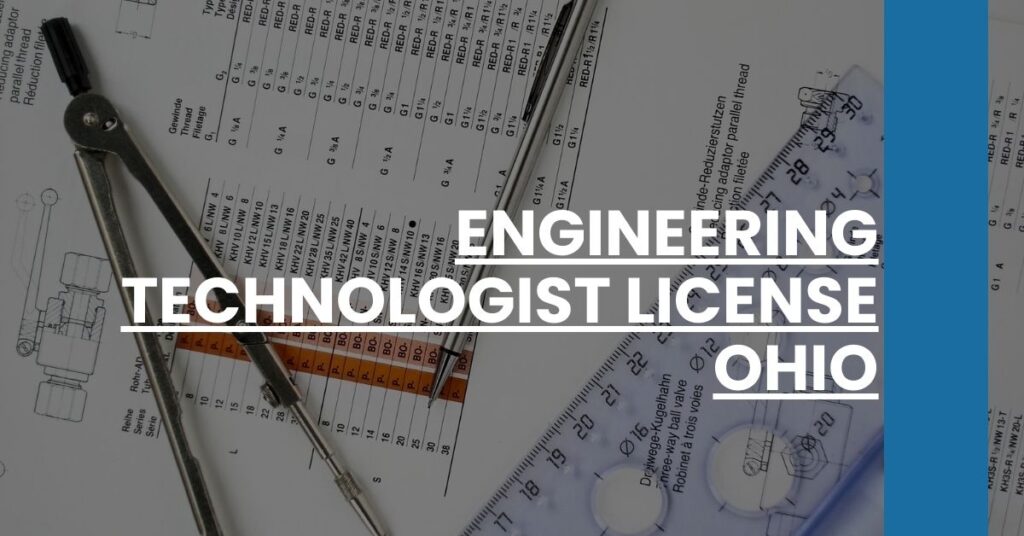Looking for schools in a specific city? Check out our lists of Engineering Technology Schools in Columbus, Cleveland, Cincinnati, Toledo, Akron, and Dayton.
Getting your Engineering Technologist License in Ohio can be a defining moment in your career. Not only does it open doors to higher-paying jobs, but it also comes with the prestige of being recognized for your skills and expertise. You might be wondering about the steps involved or if you meet the educational and professional requirements. That’s where our team’s expertise comes in.
We’ve put together a detailed guide to help you navigate the process, covering:
- Essential requirements for earning an Engineering Technologist License in Ohio
- Key educational and experience qualifications
- Step-by-step instructions to help you through exams and applications
- What Is an Engineering Technologist?
- Why Pursue an Engineering Technologist License in Ohio?
- Educational Requirements for Engineering Technologists in Ohio
- Ohio State Licensing Board for Engineering Technologists
- Steps to Get Licensed as an Engineering Technologist in Ohio
- Required Examinations for Engineering Technologists in Ohio
- Professional Experience Requirements
- Maintaining and Renewing Your Engineering Technologist License
- Common Challenges and Solutions in the Licensing Process
- Resources and Support for Aspiring Engineering Technologists
- Looking for Engineering Technologist Information On States Bordering Ohio?
- Conclusion
What Is an Engineering Technologist?
Role and Responsibilities
An engineering technologist is a professional who applies both technical and theoretical knowledge to solve complex engineering problems. These individuals often work in industries such as manufacturing, construction, and product design. They are experts at using existing technology to improve processes, increase efficiency, and enhance product quality.
Differences Between Technologists, Engineers, and Technicians
Understanding the distinction between an engineering technologist, an engineer, and a technician is crucial.
- Engineering Technologists: They focus on implementing technology, handling practical applications, and managing complex operations.
- Engineers: Primarily involved in designing and developing new technologies, engineers emphasize innovation and theoretical problem-solving.
- Technicians: Often assist both technologists and engineers, focusing on the hands-on assembly, testing, and maintenance of equipment.
By obtaining an Engineering Technologist License in Ohio, you formalize your ability to contribute significantly to engineering projects. This credential empowers you with the trust and recognition needed to advance in your career.
Why Pursue an Engineering Technologist License in Ohio?
Career Advancement
Securing an Engineering Technologist License in Ohio opens up avenues for career growth. Licensed professionals often report higher salaries and better job stability compared to their non-licensed counterparts. This credential proves your expertise, making you a valuable asset to employers.
Job Opportunities
Ohio boasts a robust job market for engineering technologists, with opportunities in various sectors including aerospace, automotive, and energy. A license can expand your job prospects, allowing you to stand out in a competitive field.
Independent Practice
A license allows you to practice independently in Ohio. This can be particularly beneficial if you’re looking to start your own consulting business or secure higher-level project management roles. Licensing ensures you meet the state’s standards and regulations, enhancing your credibility.
Educational Requirements for Engineering Technologists in Ohio
Formal Education
The journey to becoming a licensed engineering technologist in Ohio begins with the right educational background. Generally, you will need a degree in engineering technology from an Engineering Technology Accreditation Commission (ETAC/ABET) accredited program.
Accredited Programs in Ohio
Ohio offers several ETAC/ABET accredited programs designed to prepare you for the licensing process. These programs typically cover subjects such as electronics, mechanical systems, and computer engineering technologies, providing a solid foundation for your career.
If you’re considering where to pursue your degree, this list of top engineering technology schools may be helpful. Additionally, you can explore other highly recommended engineering schools.
Educational Alternatives
If you don’t graduate from an accredited program, you may face additional hurdles. Non-accredited program graduates are generally not eligible for exams or registration in Ohio. Ensuring your program is accredited simplifies the licensing process and makes you a more attractive candidate to employers.
Ohio State Licensing Board for Engineering Technologists
Board Role and Functions
The Ohio State Licensing Board is your go-to authority for guidance on becoming a licensed engineering technologist. Known officially as the State Board of Registration for Professional Engineers and Surveyors, they oversee the entire licensing process, from evaluating applications to administering exams.
Contact Information
Need guidance or have questions about the licensing process? You can contact the State Board:
- Phone: (877) 644-6364
- Email: [email protected]
Importance of the Board
Engaging with the Board is crucial for successfully navigating the licensing process. They provide detailed information on educational and experience requirements, ensuring you’re well-prepared.
Steps to Get Licensed as an Engineering Technologist in Ohio
Step-by-Step Application Guide
To get your Engineering Technologist License in Ohio, follow these steps:
- Complete an Accredited Program: Ensure you graduate from a four-year ETAC/ABET accredited engineering technology curriculum.
- Pass the Fundamentals of Engineering (FE) Exam: This exam is a critical milestone, assessing your core engineering knowledge.
- Accumulate Professional Experience: Gain at least eight years of progressive engineering experience, supervised and verified by a licensed professional engineer.
- Submit Your Application: Prepare and submit an application to the State Board of Registration for Professional Engineers and Surveyors.
- Review and Approval: The Board will review your application, verify your qualifications, and approve your eligibility for licensure.
Essential Documentation
While applying, you’ll need to provide several key documents:
- Educational Transcripts: Proving you’ve graduated from an accredited program.
- Experience Verification: Detailed records of your professional experience, endorsed by a licensed professional engineer.
- Exam Results: Proof of passing the FE exam.
Associated Fees
Licensing involves various fees, including application fees, exam fees, and renewal fees. These can vary, so check the Board’s website for the most current information.
Required Examinations for Engineering Technologists in Ohio
Fundamentals of Engineering (FE) Exam
Passing the Fundamentals of Engineering (FE) Exam is a mandatory step toward becoming a licensed engineering technologist in Ohio. Administered by the National Council of Examiners for Engineering and Surveying (NCEES), this exam evaluates your competency in essential engineering subjects.
Exam Structure
The FE Exam covers various aspects of engineering technology, including:
- Mathematics: Algebra, calculus, and differential equations.
- Engineering Sciences: Statics, dynamics, and mechanics of materials.
- Electrical Engineering: Circuit analysis, electronics, and control systems.
- Chemistry and Materials Science: Basic concepts and applications in engineering.
Preparatory Tips
Successful exam preparation can set you on the path to licensure:
- Study Materials: Utilize NCEES-approved study guides and practice tests.
- Prep Courses: Consider enrolling in exam prep courses to solidify your understanding. Websites like cet101.com offer resources tailored for engineering technology exams.
- Time Management: Develop a study schedule that allows ample time to cover all subject areas.
Passing Criteria
The FE Exam typically requires a score above 70% to pass, though this can vary. The Board will notify you of your results and the next steps upon passing.
Use this comprehensive guide to navigate your journey toward becoming a licensed engineering technologist in Ohio. By following these steps and leveraging the resources provided, you’ll be well-equipped to achieve your professional goals.
Professional Experience Requirements
Understanding the Required Experience
Becoming a licensed engineering technologist in Ohio requires a significant amount of professional experience. Specifically, candidates need eight years of progressive engineering experience after graduation. This experience must be acquired under the supervision of a licensed professional engineer.
Types of Acceptable Experience
To meet the Ohio licensing standards, your professional experience should encompass a broad range of engineering activities. Here are some examples:
- Design Work: Developing detailed engineering designs, plans, and specifications.
- Project Management: Overseeing engineering projects from initiation through completion, ensuring timelines and budgets are met.
- Research and Development: Conducting experiments and research to innovate or improve engineering processes and products.
- Quality Assurance: Implementing and managing quality control protocols to maintain high standards in engineering outputs.
- Field Work: Applying engineering principles in practical, real-world settings, such as construction sites or manufacturing floors.
Documenting Experience
Accurately documenting your professional experience is crucial. You’ll need to:
- Maintain Detailed Records: Keep track of your projects, responsibilities, and any significant achievements.
- Get Endorsements: Have your experience verified by a licensed professional engineer who has supervised your work. This endorsement is a key requirement for your application.
Maintaining and Renewing Your Engineering Technologist License
Understanding the Renewal Process
Maintaining your Engineering Technologist License in Ohio involves periodic renewals, which are essential to ensure you remain in good standing with the state board. Licenses must be renewed biennially (every two years).
Continuing Education Requirements
Ohio mandates that licensed engineering technologists complete continuing education to stay current with industry standards and practices.
- Professional Development Hours (PDH): You need 30 PDHs every renewal cycle. These can be obtained through various activities, including professional courses, seminars, workshops, and online education programs.
Renewal Steps
To renew your license, you must:
- Complete Continuing Education: Ensure you’ve met the continuing education requirements. Keep records of all your PDH activities.
- Submit Renewal Application: Fill out the renewal form provided by the Ohio State Licensing Board.
- Pay Fees: Submit the required renewal fees along with your application.
Common Challenges and Solutions in the Licensing Process
Meeting Experience Requirements
One of the most common challenges is meeting the stringent experience requirements. To address this, consider the following:
- Mentorship: Find a mentor who is a licensed professional engineer. They can guide you through complex projects and provide valuable endorsements.
- Networking: Join professional organizations and attend local events. Networking can facilitate finding opportunities that align with the required experience.
Preparing for Exams
Many candidates find the exam process demanding. However, several resources can help:
- Prep Courses: Enroll in specialized preparation courses that focus on the FE exam. Websites like cet101.com offer relevant study materials.
- Study Groups: Joining or forming study groups can provide moral support and enhance your preparation through shared knowledge.
Resources and Support for Aspiring Engineering Technologists
Valuable Resources
Several resources are available to help you on your path:
- National Society of Professional Engineers (NSPE): Offers exam prep materials, certification programs, and networking opportunities.
- Ohio-based Engineering Societies: These local chapters provide support and resources tailored to state-specific requirements.
Professional Organizations
Becoming a member of professional organizations is beneficial:
- Networking: Connect with other professionals for advice, job opportunities, and mentorship.
- Continual Learning: Access to workshops, seminars, and webinars that count toward your PDH requirements.
By leveraging these resources, you can navigate the licensing process more effectively and advance your career as an engineering technologist in Ohio.
Looking for Engineering Technologist Information On States Bordering Ohio?
In addition to Ohio, we suggest looking for schools in nearby states.
- Engineering Technologist License Pennsylvania
- Engineering Technologist License West Virginia
- Engineering Technologist License Kentucky
- Engineering Technologist License Indiana
- Engineering Technologist License Michigan
Conclusion
Obtaining your Engineering Technologist License in Ohio can significantly enhance your career opportunities. By following the right educational paths, gaining the requisite experience, and leveraging available resources, you can successfully achieve this credential. If you’re ready to take the next step, explore the additional steps here and start your journey towards becoming a licensed engineering technologist.

